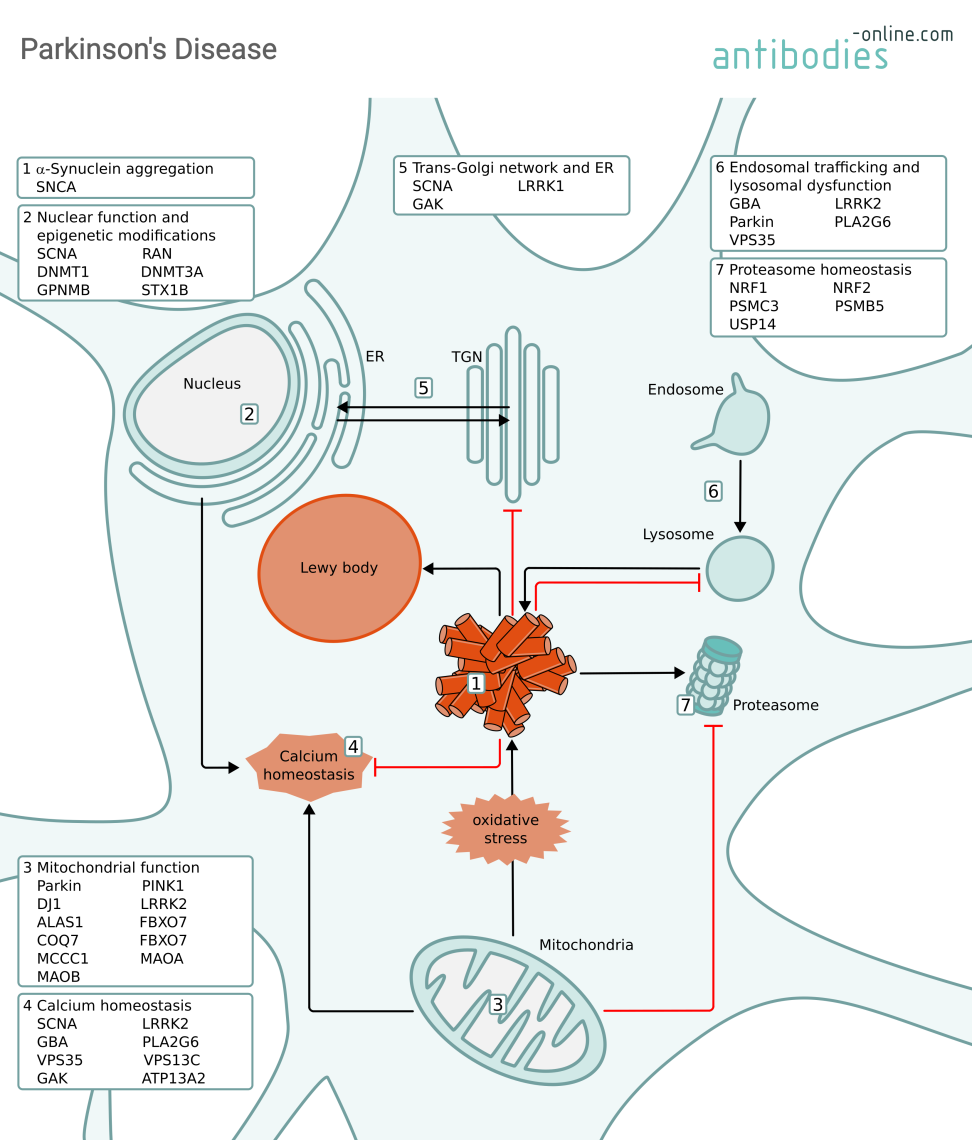Parkinson's Disease
Parkinson’s Disease (PD) is the second most common neurodegenerative disease. It is a chronic progressive disorder of the central nervous system, characterized by four cardinal motor symptoms: tremor, bradykinesia, rigidity, and postural instability. With disease progression, non-motor symptoms may also arise, including cognitive decline, altered behavior, and sleep disorders. PD typically emerges at 60 years of age and older with an incidence of approximately 150–200/100,000 individuals. It is more prevalent in men than in women. Most cases of PD are caused by environmental factors. However, 10-15% of the cases are early-onset familial PD and genome-wide associated studies have identified more than 40 genetic risk factors.
On a cellular level, PD is characterized by the progressive loss of dopaminergic neurons in the substantia nigra pars compacta (SNc), a region of the midbrain responsible for motor control. Degeneration of these neurons leads to decreased dopamine production and altered signaling in the striatum of the basal ganglia contributing to fine motor control. Motor symptoms typically appear when 50-80% of the SNc dopaminergic neurons have degenerated. Each side of the human SNc only contains 400,000 to 500,000 dopaminergic neurons.
The predominant risk factors for PD are aging and environmental factors including mitochondrial poisons, heavy metals, pesticides, or traumatic brain injuries. Oxidative metabolism of dopamine in the dopaminergic cells by mitochondrial monoamine oxidase isoforms MAOA and MAOB leads to reactive oxygen species (ROS) generation, oxidative damage and ultimately cell death. Because of their high metabolic activity, dopaminergic neurons of the SNc are thought to be particularly sensitive to oxidative stress.
Besides idiopathic causes, mutations in several genes have been identified as susceptibility factors for PD or found to be associated with autosomal dominant or recessive forms of the disease.

Mechanisms causing neuron degeneration in PD and some of the involved proteins.
Important Targets Related to Parkinson’s Disease
More than 40 proteins have been associated with PD, including:
SNCA
Alpha-synuclein (SNCA, autosomal dominant locus PARK1) is a neuronal protein abundant in the human brain that regulates synaptic vesicle trafficking and subsequent neurotransmitter release. PD is classified as a synucleopathy because of the characteristic aggregation of misfolded alpha-synuclein.
Under pathological conditions, ROS can mediate conformational changes of normal alpha-synuclein into non-fibrillar, misfolded aggregates. Normally, misfolded alpha-synuclein protein is tagged and degraded by the ubiquitin-proteasome system and the larger aggregates undergo lysosomal degradation. They can however also form larger aggregates and insoluble clumps known as Lewy bodies. Lewy bodies (LB) are also present in the neurodegenerative disease dementia with Lewy bodies, which share symptoms with PD. The extent of the LB pathology is considered in the Braak staging of PD.
Misfolded alpha-synuclein in one neuron can induce the misfolding of alpha-synuclein in neighboring neurons. This spreading pathology possibly underlies the progressive nature of Parkinson's disease. Misfolded alpha-synuclein can disrupt various cellular processes, such as protein degradation and mitochondrial function, leading to cellular dysfunction and additional oxidative stress further driving the pathology. Neuronal toxicity caused by the accumulation of misfolded alpha-synuclein is believed to contribute to the degeneration of dopaminergic neurons in the SNc.
Lastly, aggregates of misfolded alpha-synuclein hyperactivate MAPK signaling, thus promoting neuroinflammation. Inflammation further contributes to the degeneration of neurons and the progression of the disease.
The initial formation of alpha-synuclein aggregates is usually triggered by factors causing cellular and oxidative stress. However, formation of these aggregates can also be favored by certain point mutations in the SNCA gene. Epigenetic factors such as a low level of methylation of two CpG islands in the SNCA gene have been implicated as contributing factors to PD.
SNCA Antibodies
GBA
The GBA gene encodes the lysosomal enzyme beta-glucocerebrosidase (Beta-GC) which has a central role in cell membrane turnover and the degradation of complex lipids. Mutations in this gene are the most common genetic PD risk factor: up to 10% of Parkinson’s disease patients have a mutation in GBA compared to 1% of the unaffected population. Heterozygous GBA mutation increases the PD risk five- to eightfold. Overall, more than 100 variants of the GBA gene are known that reduce the protein’s enzymatic activity, destabilize the protein, or alter its lysosomal localization.
The accumulation of Beta-GC’s substrate glucocerebroside in lysosomes leads to lysosomal dysfunction and is thought to contribute to alpha-synuclein aggregation and to further exacerbate neuroinflammation.
Heterozygous GBA mutation carriers have a five- to eightfold increased PD risk depending on the variant. Homozygous mutations in the GBA cause Gaucher’s Disease (GD), a lysosomal storage disorder that mainly affects the liver, spleen, and bones. Beyond these organs, GD can also manifest in the central nervous system and GD patients are classified into three types based on brain involvement and neurological symptoms.
GBA Antibodies
LRRK2
Leucine-Rich Repeat Kinase 2 (LRRK2, autosomal dominant locus PARK8) is a complex 253 kDa protein with multiple domains and activities that is expressed in the brain, lungs, kidneys, and immune system. LRRK2 has both GTPase and kinase activities. Mutations in the LRRK2 gene are the second most common genetic risk factor for sporadic PD and account for up to 1% of PD cases. LRRK2 mutations are also among the most common causes of familial PD and individuals who inherit gain of function mutations in LRRK2 are at higher risk to develop the disease in later life. Increased kinase activity is thought to drive the pathogenic effect of LRRK2 variant associated with PD.
Because of the wide range of kinase substrates, LRRK2 neuropathology is very diverse. LRRK2 mutations may influence alpha-synuclein and have been linked to neuroinflammation, and mitochondrial and ubiquitin-proteasome dysfunction – all contributing factors to PD.
Recent investigations have shown that small-molecule LRRK2 inhibitors can be neuroprotective, suggesting that therapies targeting LRRK2 could be beneficial in a larger population of patients.
LRRK2 Antibodies
VPS35
The vacuolar protein sorting 35 (VPS35, autosomal dominant locus PARK17) is part of the retromer protein complex, which is responsible for sorting of proteins from the endosome to the cell membrane and trans-Golgi network. VPS35 recruits the WASH complex to the endosomal membrane which is necessary for endosomal protein sorting.
The VPS35 D620N mutation is present in 0.1-1% of patients with familial PD. This mutant has been shown to associate poorly with the WASH complex and compromise its recruitment to the endosome. VPS35 D620N has also been implicated in mitochondrial dysfunction. Therefore, mutations in VPS35 might contribute to PD through disrupted lysosomal activity and consequently the accumulation of alpha-synuclein aggregates and increase oxidative stress through mitochondrial dysfunction.
VPS35 Antibodies
Parkin
The E3 ubiquitin protein ligase parkin (PRKN, autosomal recessive locus PARK2) coordinates mitochondrial control mechanisms and modulates lysosomal homeostasis under cell stress. It also regulates mitochondria-lysosome contact sites.
Mutations in PRKN are the most common cause of early-onset Parkinson’s. Loss of parkin’s E3 ligase activity is thought to play a pathogenic role in both inherited and sporadic PD.
Parkin Antibodies
References
- : "Mutations in LRRK2 cause autosomal-dominant parkinsonism with pleomorphic pathology." in: Neuron, Vol. 44, Issue 4, pp. 601-7, (2004) (PubMed).
- : "A common LRRK2 mutation in idiopathic Parkinson's disease." in: Lancet, Vol. 365, Issue 9457, pp. 415-6, (2005) (PubMed).
- : "Multicenter analysis of glucocerebrosidase mutations in Parkinson's disease." in: The New England journal of medicine, Vol. 361, Issue 17, pp. 1651-61, (2009) (PubMed).
- : "Mutation in VPS35 associated with Parkinson's disease impairs WASH complex association and inhibits autophagy." in: Nature communications, Vol. 5, pp. 3828, (2014) (PubMed).
- : "The role of Ca2+ signaling in Parkinson's disease." in: Disease models & mechanisms, Vol. 10, Issue 5, pp. 519-535, (2018) (PubMed).
- : "A meta-analysis of genome-wide association studies identifies 17 new Parkinson's disease risk loci." in: Nature genetics, Vol. 49, Issue 10, pp. 1511-1516, (2017) (PubMed).
- : "Parkinson's Disease: Biomarkers, Treatment, and Risk Factors." in: Frontiers in neuroscience, Vol. 12, pp. 612, (2018) (PubMed).
- : "Dopamine: Functions, Signaling, and Association with Neurological Diseases." in: Cellular and molecular neurobiology, Vol. 39, Issue 1, pp. 31-59, (2019) (PubMed).
- : "Emerging therapies in Parkinson disease - repurposed drugs and new approaches." in: Nature reviews. Neurology, Vol. 15, Issue 4, pp. 204-223, (2020) (PubMed).
- : "The mechanistic role of alpha-synuclein in the nucleus: impaired nuclear function caused by familial Parkinson's disease SNCA mutations." in: Human molecular genetics, Vol. 29, Issue 18, pp. 3107-3121, (2021) (PubMed).
- : "Mitochondria and Parkinson's Disease: Clinical, Molecular, and Translational Aspects." in: Journal of Parkinson's disease, Vol. 11, Issue 1, pp. 45-60, (2021) (PubMed).
- : "Mitochondrial and Clearance Impairment in p.D620N VPS35 Patient-Derived Neurons." in: Movement disorders : official journal of the Movement Disorder Society, Vol. 36, Issue 3, pp. 704-715, (2021) (PubMed).
- : "Influence of energy deficiency on the subcellular processes of Substantia Nigra Pars Compacta cell for understanding Parkinsonian neurodegeneration." in: Scientific reports, Vol. 11, Issue 1, pp. 1754, (2021) (PubMed).
- : "Expanding the role of proteasome homeostasis in Parkinson's disease: beyond protein breakdown." in: Cell death & disease, Vol. 12, Issue 2, pp. 154, (2021) (PubMed).
- : "Parkinson's Disease Genetics and Pathophysiology." in: Annual review of neuroscience, Vol. 44, pp. 87-108, (2021) (PubMed).
- : "A Review of the Common Neurodegenerative Disorders: Current Therapeutic Approaches and the Potential Role of Nanotherapeutics." in: International journal of molecular sciences, Vol. 23, Issue 3, (2022) (PubMed).
- : "Evidence That Substantia Nigra Pars Compacta Dopaminergic Neurons Are Selectively Vulnerable to Oxidative Stress Because They Are Highly Metabolically Active." in: Frontiers in cellular neuroscience, Vol. 16, pp. 826193, (2022) (PubMed).
- : "GPNMB confers risk for Parkinson's disease through interaction with α-synuclein." in: Science (New York, N.Y.), Vol. 377, Issue 6608, pp. eabk0637, (2022) (PubMed).
- : "Parkin regulates amino acid homeostasis at mitochondria-lysosome (M/L) contact sites in Parkinson's disease." in: Science advances, Vol. 9, Issue 29, pp. eadh3347, (2023) (PubMed).

Goal-oriented, time line driven scientist, proficiently trained in different academic institutions in Germany, France and the USA. Experienced in the life sciences e-commerce environment with a focus on product development and customer relation management.
Go to author page



